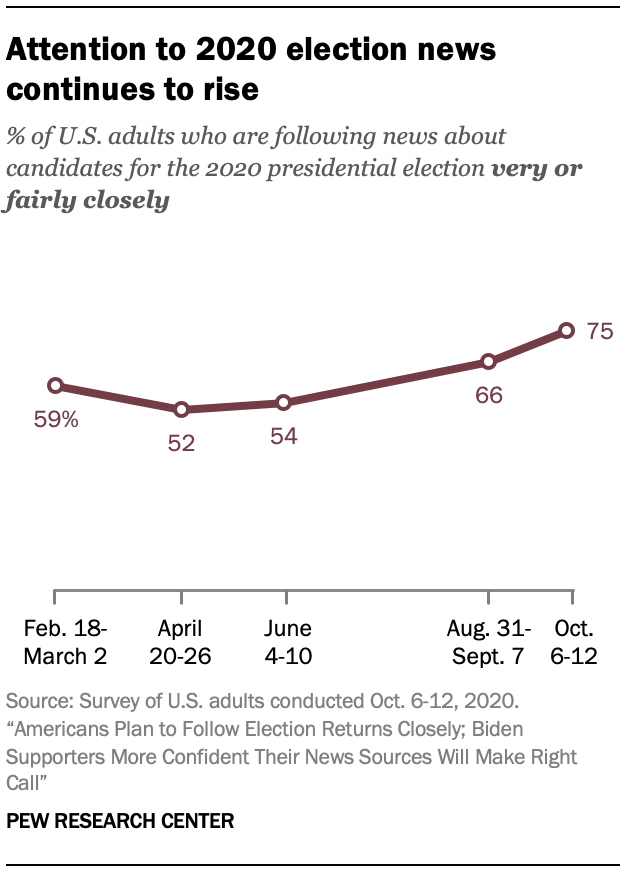
Interest in the 2020 election has increased over the last month. Three-quarters of U.S. adults now say they are following news about candidates for the presidential election “very” or “fairly” closely, including 39% who are doing so very closely. That is up about 10 percentage points from early September, when 66% said the same. Attention to the election is now roughly on par with interest in news about the coronavirus outbreak, which 79% now say they are following fairly or very closely. It does still trail the height of interest in COVID-19 news in late March, when 92% said they were following it closely and nearly six-in-ten were following it very closely.
Interest in election news is high among both Trump and Biden supporters. About half of registered voters who support Trump (49%) and Biden (53%) say they are following election news very closely.
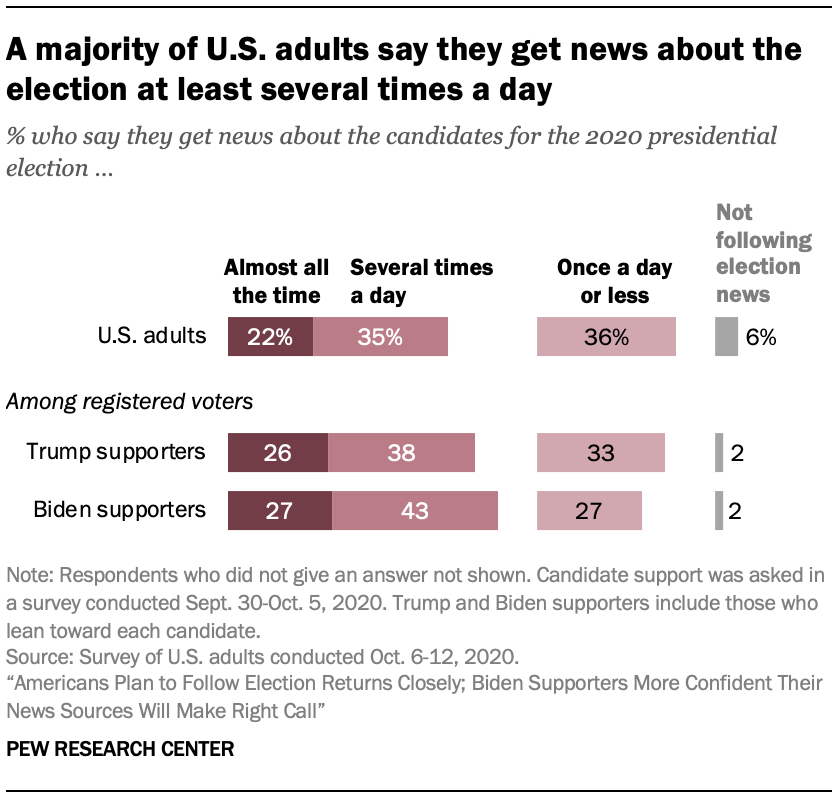
Increased attention to election news coincides with people getting many updates throughout the day. About six-in-ten U.S. adults (57%) say they are getting news about the candidates at least several times a day, with about two-in-ten (22%) who do so almost all the time.
The frequency of updates is very consistent across Trump and Biden supporters, with about a quarter of registered voters in each group getting updates almost all the time and majorities doing so at least several times a day.
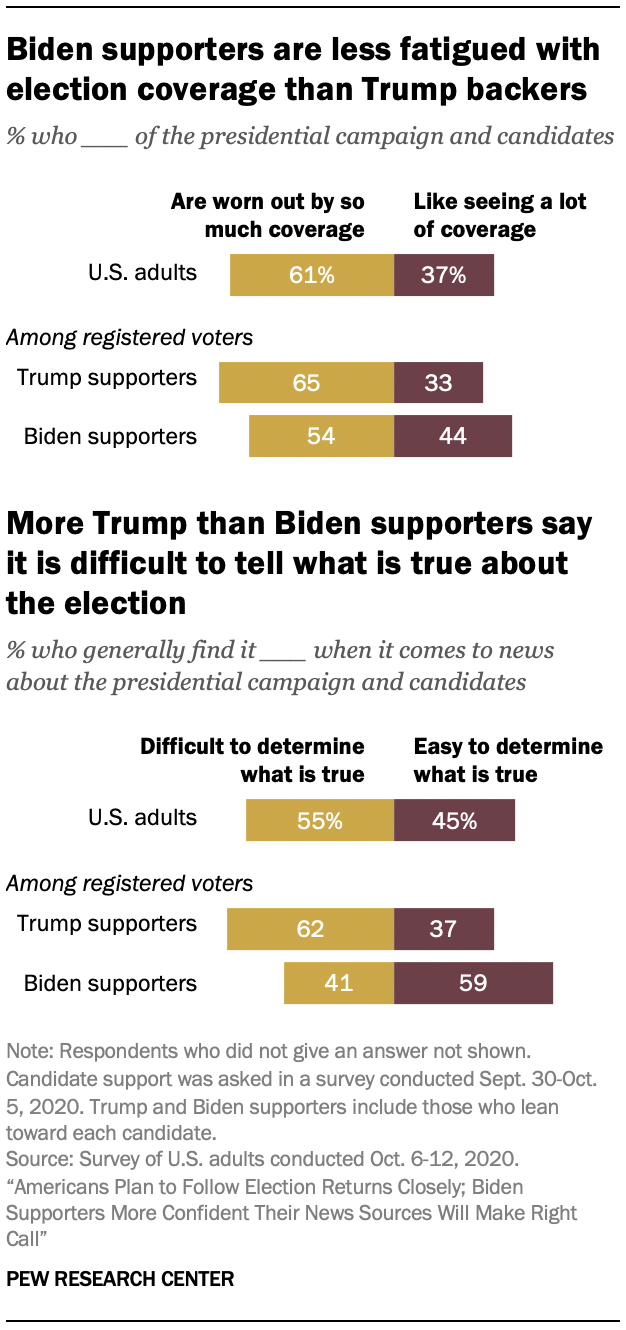
One area of difference between these groups of supporters is in the level of weariness brought on by keeping up with the news. About two-thirds of Trump supporters (65%) say they are worn out by so much coverage. That compares to just over half of Biden supporters (54%) who are worn out, while 44% say they like a lot of attention on the election.
Overall, about six-in-ten Americans (61%) say they are worn out by so much coverage of the 2020 presidential election.
Trump supporters are also more likely than Biden supporters to say they are finding it difficult to determine what is true and what is not about the presidential campaign.
Overall, U.S. adults are somewhat more likely to say they find this difficult (55%) than to say they find it easy (45%). That gap grows among registered voters supporting Trump. About six-in-ten (62%) say they find it difficult, while 37% find it easy. The figures for Biden are nearly flipped, with 59% finding it easy and 41% finding it difficult.
Biden supporters more likely to discuss the election with others, stop talking to someone because of something they said
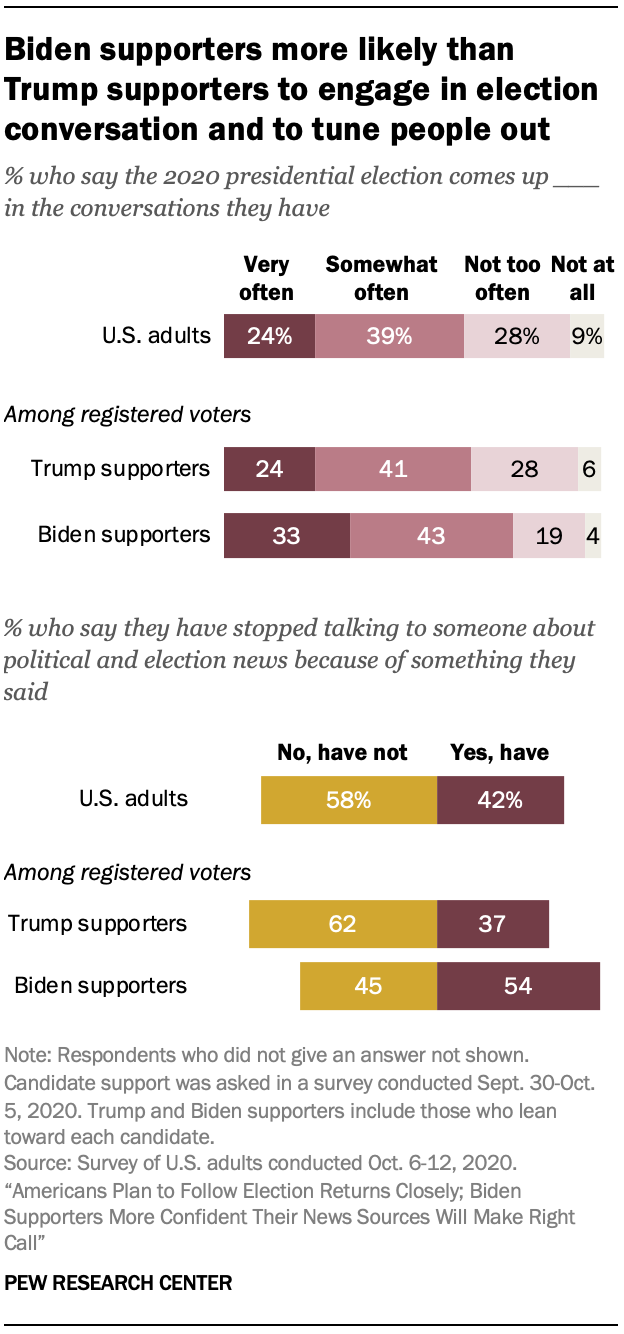
Americans are frequently talking about the upcoming election with others, with Biden supporters more likely to be doing so than those who are planning to vote for Trump.
About a quarter (24%) of U.S. adults say the 2020 presidential election comes up in conversation “very often,” while another 39% say it comes up “somewhat often.” Just 9% say the election does not come up in their conversations at all.
The topic of conversation is somewhat more frequent among registered voters who say they support Biden for president than among those who support Trump. A third of Biden supporters say the topic comes up very often compared with about a quarter (24%) of Trump supporters.
The focus of these conversations also differs somewhat between the two groups of supporters. Biden supporters are more likely to say much of their election discussions focus on the candidates’ personalities and comments than are Trump supporters (71% vs. 51%). Conversely, Trump supporters are more likely than Biden supporters to say their conversations are about the issues (42% vs. 24%). (See the Pathways data tool for more about this question tk – link to CAMPISSUE in data tool)
Even as Biden supporters discuss the 2020 election more frequently, they are also more likely than Trump supporters to cut off conversation about political and election news with someone because of something they said.
Overall, about four-in-ten Americans say they have stopped talking to someone because of something they said (42% have, and 58% say they have not done this). Biden supporters are more likely to do this – 54% of registered voters who support Biden say they have stopped talking to someone about political and election news because of something they said, compared with 37% of Trump supporters.
Most Americans say the news sources they turn to most have covered the election well
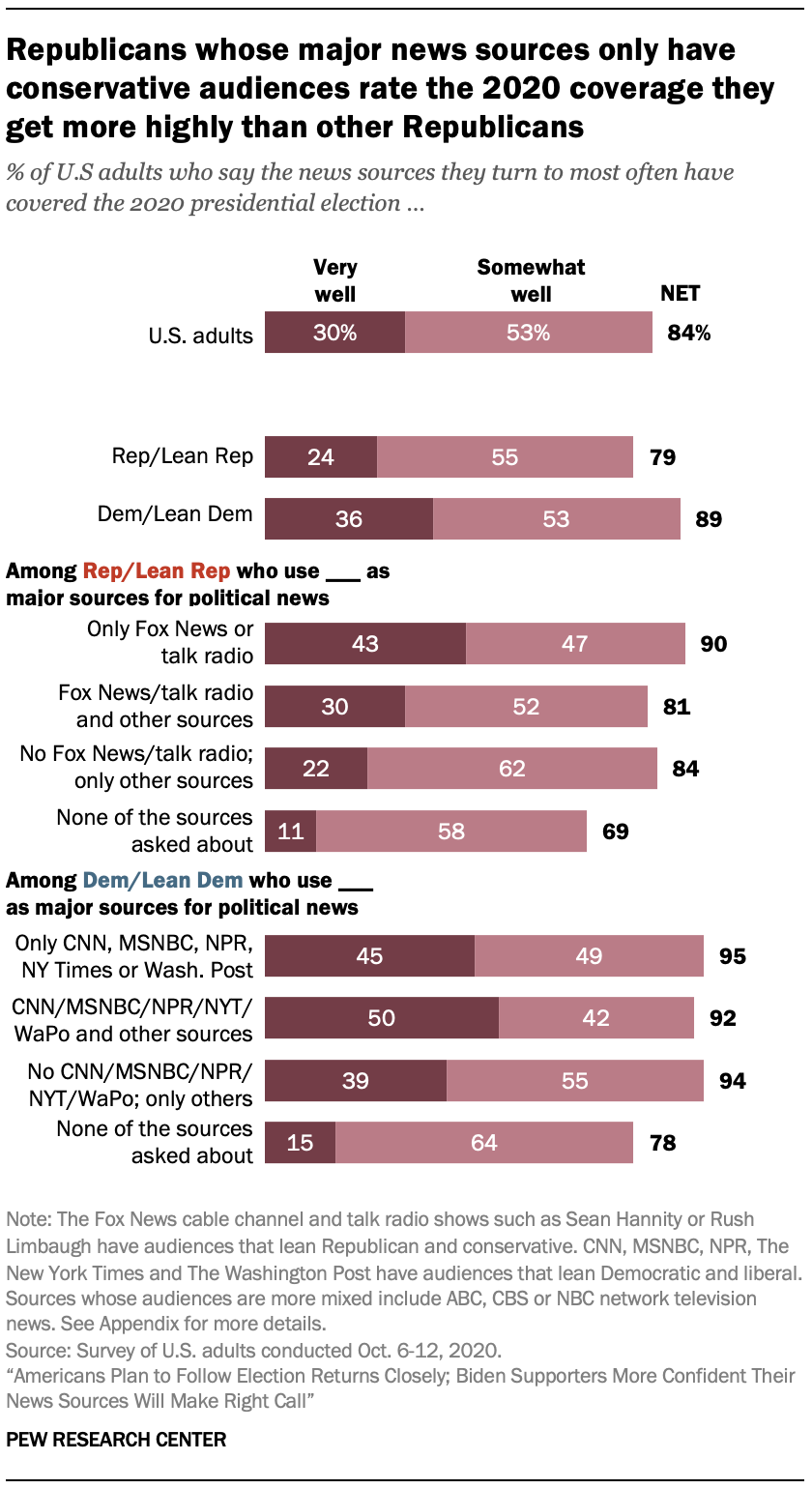
Most Americans (84%) say the news sources they turn to most often are covering the 2020 presidential election well. Three-in-ten say their most-relied on news sources have covered the election very well, while about half (53%) say these outlets have covered it somewhat well. Few U.S. adults say their most commonly used news outlets have covered the presidential election either not too well (12%) or not at all well (4%).
Democrats and independents who lean toward the Democratic Party give the news sources they turn to most higher marks for their coverage than do Republicans and Republican-leaning independents.
Nearly four-in-ten Democrats (36%) say their most-used news sources have covered the election very well, compared with about a quarter of Republicans (24%) who say the same. Roughly similar shares of Republicans and Democrats say the outlets they commonly use have done somewhat well (55% and 53%, respectively).
[LINK]
Republicans who use only Fox News and/or talk radio like Sean Hannity or Rush Limbaugh as major sources of news give much higher scores for how well their most-used news sources have covered the election (43% say very well) than Republicans who primarily use news sources with more politically mixed audiences (30% among Republicans who use Fox News or talk radio plus other outlets, and 22% among Republicans who use other outlets as major sources but not Fox News or talk radio). Republicans who do not use any of the eight sources asked about are generally the most negative about how well their most used news sources are performing.
There is less of a clear pattern among Democrats, with only modest differences in assessments of coverage between those who use outlets with left-leaning audiences and those who do not. Again, Democrats who do not use any of the eight news sources asked about are generally the most negative overall.
Asked in more detail to rate how well the news sources they turn to most often have covered a selection of six aspects of the 2020 election, Democrats and Democratic-leaning independents rate their outlets more highly than Republicans and Republican-leaning independents on all six.
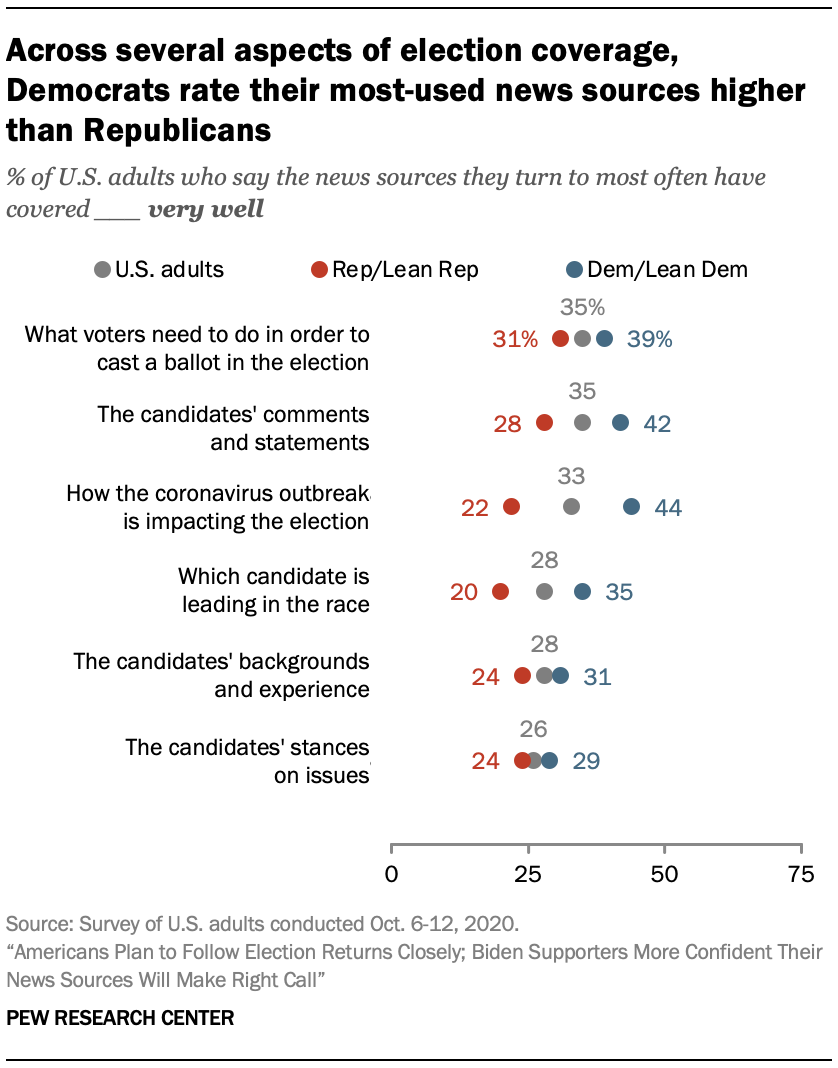
One of the largest gaps between Republicans and Democrats is for the coverage in their most commonly used outlets of how the coronavirus outbreak is impacting the election. Slightly more than four-in-ten Democrats (44%) say their news outlets have covered this topic very well, compared with half as many Republicans (22%).
Additionally, there is a 15 percentage point gap between the shares of Republicans (20%) and Democrats (35%) who say the news outlets they use most have done very well covering which candidate is leading in the race, as well as a 14-point gap in shares saying the candidates’ comments and statements have been covered very well (42% of Democrats vs. 28% of Republicans). The partisan gaps are more modest (about 10 points or less) on the other three items, including what voters need to do in order to cast a ballot, the candidates’ backgrounds and experience, and the candidates’ stances on the issues.
Media diet within party is linked with differences here as well, though of a different nature. Among both Republicans and Democrats (including leaners in both parties), those who give their commonly used media sources the lowest marks are generally those who use news outlets with audiences that do not align with their personal political views.
Compared with Republicans who turn to Fox News and/or talk radio as major sources, Republicans who turn to other major sources instead are the least likely to say their news sources are covering five of these six storylines very well.
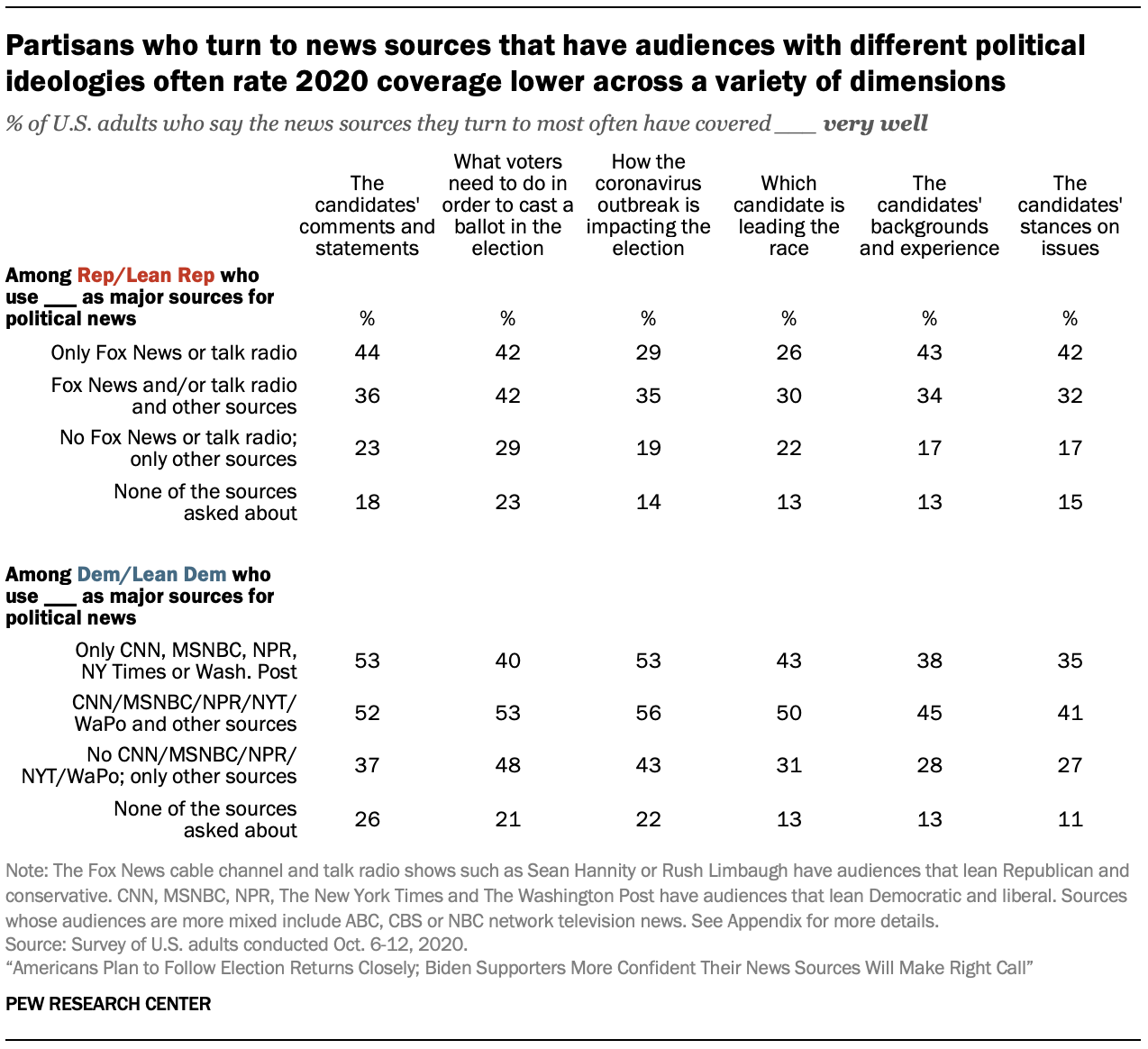
The story is similar among Democrats. Democrats who do not use outlets with left-leaning audiences as major sources give lower ratings on five of the six dimensions compared with Democrats who use outlets with left-leaning audiences.
The two groups who turn to none of the major sources asked about tend to be the most negative groups on most of these measures.




